Kun Zhao
DRE: An Effective Dual-Refined Method for Integrating Small and Large Language Models in Open-Domain Dialogue Evaluation
Jun 04, 2025Abstract:Large Language Models (LLMs) excel at many tasks but struggle with ambiguous scenarios where multiple valid responses exist, often yielding unreliable results. Conversely, Small Language Models (SLMs) demonstrate robustness in such scenarios but are susceptible to misleading or adversarial inputs. We observed that LLMs handle negative examples effectively, while SLMs excel with positive examples. To leverage their complementary strengths, we introduce SLIDE (Small and Large Integrated for Dialogue Evaluation), a method integrating SLMs and LLMs via adaptive weighting. Building on SLIDE, we further propose a Dual-Refinement Evaluation (DRE) method to enhance SLM-LLM integration: (1) SLM-generated insights guide the LLM to produce initial evaluations; (2) SLM-derived adjustments refine the LLM's scores for improved accuracy. Experiments demonstrate that DRE outperforms existing methods, showing stronger alignment with human judgment across diverse benchmarks. This work illustrates how combining small and large models can yield more reliable evaluation tools, particularly for open-ended tasks such as dialogue evaluation.
LMFormer: Lane based Motion Prediction Transformer
Apr 14, 2025Abstract:Motion prediction plays an important role in autonomous driving. This study presents LMFormer, a lane-aware transformer network for trajectory prediction tasks. In contrast to previous studies, our work provides a simple mechanism to dynamically prioritize the lanes and shows that such a mechanism introduces explainability into the learning behavior of the network. Additionally, LMFormer uses the lane connection information at intersections, lane merges, and lane splits, in order to learn long-range dependency in lane structure. Moreover, we also address the issue of refining the predicted trajectories and propose an efficient method for iterative refinement through stacked transformer layers. For benchmarking, we evaluate LMFormer on the nuScenes dataset and demonstrate that it achieves SOTA performance across multiple metrics. Furthermore, the Deep Scenario dataset is used to not only illustrate cross-dataset network performance but also the unification capabilities of LMFormer to train on multiple datasets and achieve better performance.
FantasyTalking: Realistic Talking Portrait Generation via Coherent Motion Synthesis
Apr 07, 2025Abstract:Creating a realistic animatable avatar from a single static portrait remains challenging. Existing approaches often struggle to capture subtle facial expressions, the associated global body movements, and the dynamic background. To address these limitations, we propose a novel framework that leverages a pretrained video diffusion transformer model to generate high-fidelity, coherent talking portraits with controllable motion dynamics. At the core of our work is a dual-stage audio-visual alignment strategy. In the first stage, we employ a clip-level training scheme to establish coherent global motion by aligning audio-driven dynamics across the entire scene, including the reference portrait, contextual objects, and background. In the second stage, we refine lip movements at the frame level using a lip-tracing mask, ensuring precise synchronization with audio signals. To preserve identity without compromising motion flexibility, we replace the commonly used reference network with a facial-focused cross-attention module that effectively maintains facial consistency throughout the video. Furthermore, we integrate a motion intensity modulation module that explicitly controls expression and body motion intensity, enabling controllable manipulation of portrait movements beyond mere lip motion. Extensive experimental results show that our proposed approach achieves higher quality with better realism, coherence, motion intensity, and identity preservation. Ours project page: https://fantasy-amap.github.io/fantasy-talking/.
One Snapshot is All You Need: A Generalized Method for mmWave Signal Generation
Mar 27, 2025Abstract:Wireless sensing systems, particularly those using mmWave technology, offer distinct advantages over traditional vision-based approaches, such as enhanced privacy and effectiveness in poor lighting conditions. These systems, leveraging FMCW signals, have shown success in human-centric applications like localization, gesture recognition, and so on. However, comprehensive mmWave datasets for diverse applications are scarce, often constrained by pre-processed signatures (e.g., point clouds or RA heatmaps) and inconsistent annotation formats. To overcome these limitations, we propose mmGen, a novel and generalized framework tailored for full-scene mmWave signal generation. By constructing physical signal transmission models, mmGen synthesizes human-reflected and environment-reflected mmWave signals from the constructed 3D meshes. Additionally, we incorporate methods to account for material properties, antenna gains, and multipath reflections, enhancing the realism of the synthesized signals. We conduct extensive experiments using a prototype system with commercial mmWave devices and Kinect sensors. The results show that the average similarity of Range-Angle and micro-Doppler signatures between the synthesized and real-captured signals across three different environments exceeds 0.91 and 0.89, respectively, demonstrating the effectiveness and practical applicability of mmGen.
GRAPHMOE: Amplifying Cognitive Depth of Mixture-of-Experts Network via Introducing Self-Rethinking Mechanism
Jan 14, 2025



Abstract:Traditional Mixture-of-Experts (MoE) networks benefit from utilizing multiple smaller expert models as opposed to a single large network. However, these experts typically operate independently, leaving a question open about whether interconnecting these models could enhance the performance of MoE networks. In response, we introduce GRAPHMOE, a novel method aimed at augmenting the cognitive depth of language models via a self-rethinking mechanism constructed on Pseudo GraphMoE networks. GRAPHMOE employs a recurrent routing strategy to simulate iterative thinking steps, thereby facilitating the flow of information among expert nodes. We implement the GRAPHMOE architecture using Low-Rank Adaptation techniques (LoRA) and conduct extensive experiments on various benchmark datasets. The experimental results reveal that GRAPHMOE outperforms other LoRA based models, achieving state-of-the-art (SOTA) performance. Additionally, this study explores a novel recurrent routing strategy that may inspire further advancements in enhancing the reasoning capabilities of language models.
MeloTrans: A Text to Symbolic Music Generation Model Following Human Composition Habit
Oct 17, 2024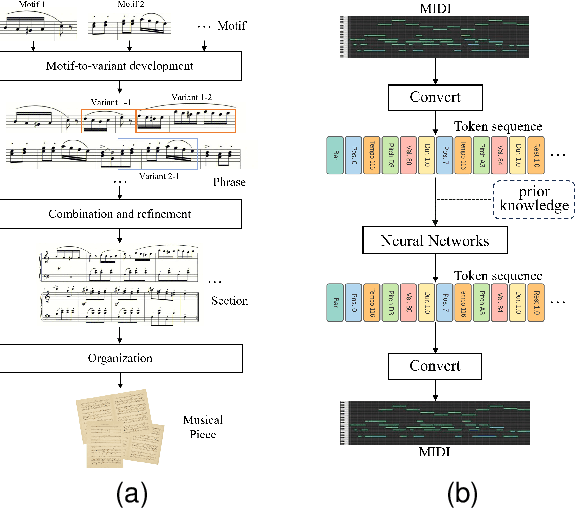

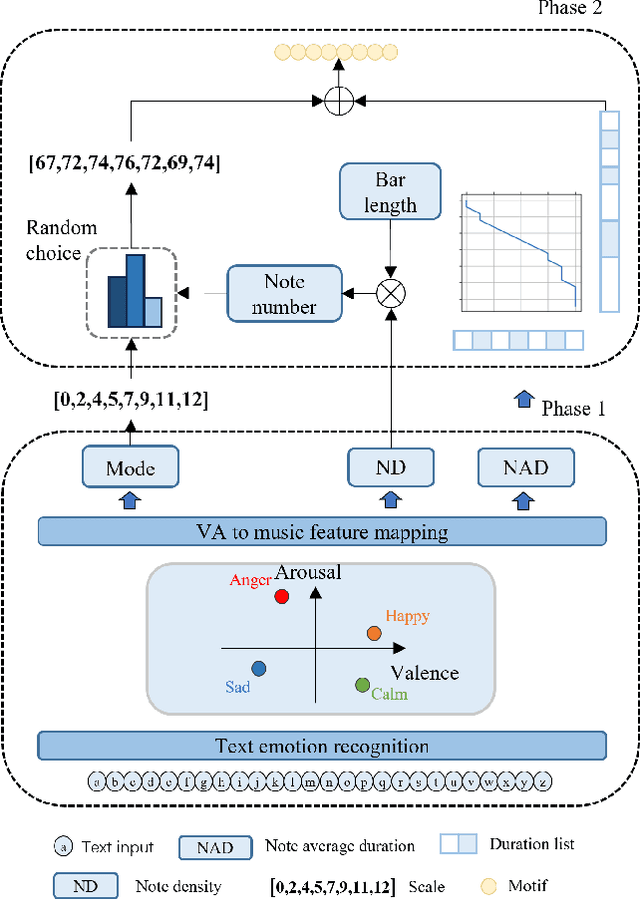
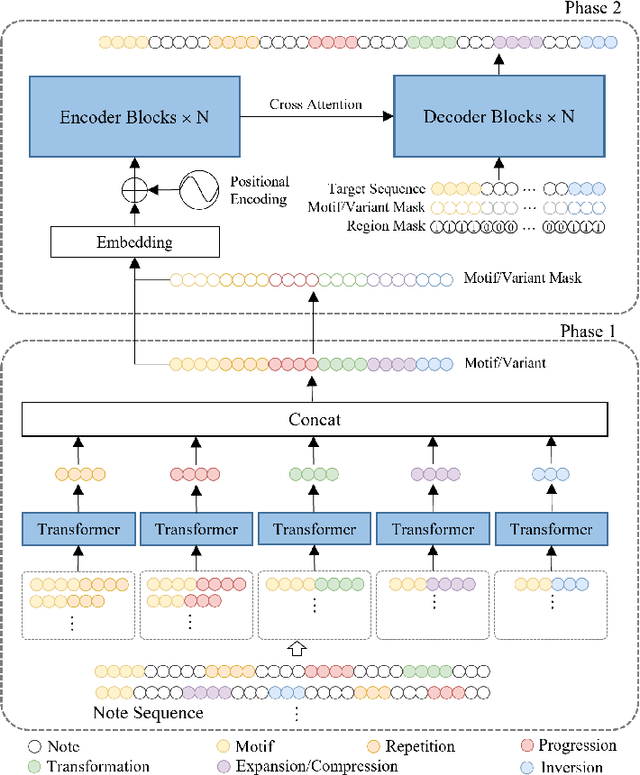
Abstract:At present, neural network models show powerful sequence prediction ability and are used in many automatic composition models. In comparison, the way humans compose music is very different from it. Composers usually start by creating musical motifs and then develop them into music through a series of rules. This process ensures that the music has a specific structure and changing pattern. However, it is difficult for neural network models to learn these composition rules from training data, which results in a lack of musicality and diversity in the generated music. This paper posits that integrating the learning capabilities of neural networks with human-derived knowledge may lead to better results. To archive this, we develop the POP909$\_$M dataset, the first to include labels for musical motifs and their variants, providing a basis for mimicking human compositional habits. Building on this, we propose MeloTrans, a text-to-music composition model that employs principles of motif development rules. Our experiments demonstrate that MeloTrans excels beyond existing music generation models and even surpasses Large Language Models (LLMs) like ChatGPT-4. This highlights the importance of merging human insights with neural network capabilities to achieve superior symbolic music generation.
CASPFormer: Trajectory Prediction from BEV Images with Deformable Attention
Sep 26, 2024



Abstract:Motion prediction is an important aspect for Autonomous Driving (AD) and Advance Driver Assistance Systems (ADAS). Current state-of-the-art motion prediction methods rely on High Definition (HD) maps for capturing the surrounding context of the ego vehicle. Such systems lack scalability in real-world deployment as HD maps are expensive to produce and update in real-time. To overcome this issue, we propose Context Aware Scene Prediction Transformer (CASPFormer), which can perform multi-modal motion prediction from rasterized Bird-Eye-View (BEV) images. Our system can be integrated with any upstream perception module that is capable of generating BEV images. Moreover, CASPFormer directly decodes vectorized trajectories without any postprocessing. Trajectories are decoded recurrently using deformable attention, as it is computationally efficient and provides the network with the ability to focus its attention on the important spatial locations of the BEV images. In addition, we also address the issue of mode collapse for generating multiple scene-consistent trajectories by incorporating learnable mode queries. We evaluate our model on the nuScenes dataset and show that it reaches state-of-the-art across multiple metrics
Predicting T-Cell Receptor Specificity
Jul 27, 2024



Abstract:Researching the specificity of TCR contributes to the development of immunotherapy and provides new opportunities and strategies for personalized cancer immunotherapy. Therefore, we established a TCR generative specificity detection framework consisting of an antigen selector and a TCR classifier based on the Random Forest algorithm, aiming to efficiently screen out TCRs and target antigens and achieve TCR specificity prediction. Furthermore, we used the k-fold validation method to compare the performance of our model with ordinary deep learning methods. The result proves that adding a classifier to the model based on the random forest algorithm is very effective, and our model generally outperforms ordinary deep learning methods. Moreover, we put forward feasible optimization suggestions for the shortcomings and challenges of our model found during model implementation.
Panoptic Segmentation of Mammograms with Text-To-Image Diffusion Model
Jul 19, 2024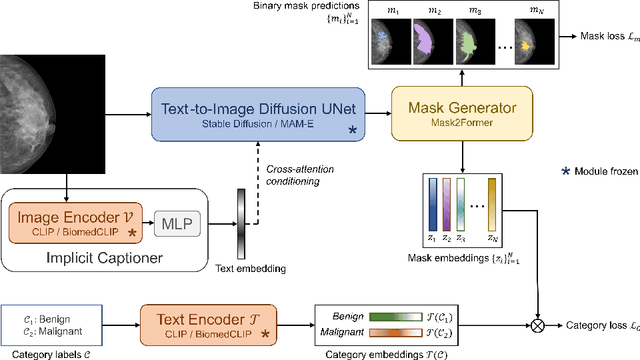

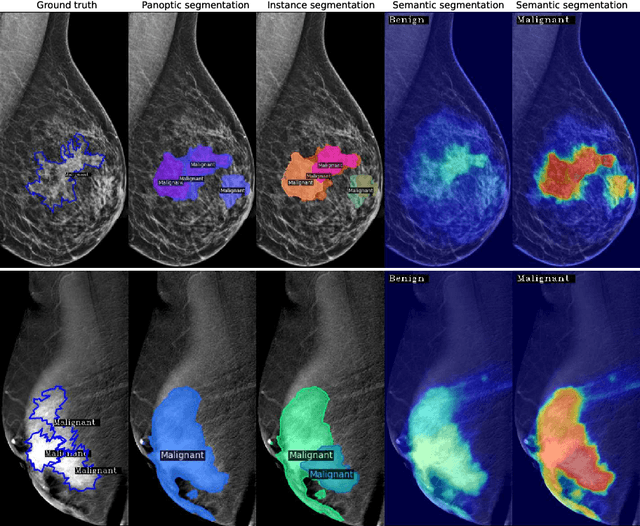

Abstract:Mammography is crucial for breast cancer surveillance and early diagnosis. However, analyzing mammography images is a demanding task for radiologists, who often review hundreds of mammograms daily, leading to overdiagnosis and overtreatment. Computer-Aided Diagnosis (CAD) systems have been developed to assist in this process, but their capabilities, particularly in lesion segmentation, remained limited. With the contemporary advances in deep learning their performance may be improved. Recently, vision-language diffusion models emerged, demonstrating outstanding performance in image generation and transferability to various downstream tasks. We aim to harness their capabilities for breast lesion segmentation in a panoptic setting, which encompasses both semantic and instance-level predictions. Specifically, we propose leveraging pretrained features from a Stable Diffusion model as inputs to a state-of-the-art panoptic segmentation architecture, resulting in accurate delineation of individual breast lesions. To bridge the gap between natural and medical imaging domains, we incorporated a mammography-specific MAM-E diffusion model and BiomedCLIP image and text encoders into this framework. We evaluated our approach on two recently published mammography datasets, CDD-CESM and VinDr-Mammo. For the instance segmentation task, we noted 40.25 AP0.1 and 46.82 AP0.05, as well as 25.44 PQ0.1 and 26.92 PQ0.05. For the semantic segmentation task, we achieved Dice scores of 38.86 and 40.92, respectively.
BioMNER: A Dataset for Biomedical Method Entity Recognition
Jun 28, 2024Abstract:Named entity recognition (NER) stands as a fundamental and pivotal task within the realm of Natural Language Processing. Particularly within the domain of Biomedical Method NER, this task presents notable challenges, stemming from the continual influx of domain-specific terminologies in scholarly literature. Current research in Biomedical Method (BioMethod) NER suffers from a scarcity of resources, primarily attributed to the intricate nature of methodological concepts, which necessitate a profound understanding for precise delineation. In this study, we propose a novel dataset for biomedical method entity recognition, employing an automated BioMethod entity recognition and information retrieval system to assist human annotation. Furthermore, we comprehensively explore a range of conventional and contemporary open-domain NER methodologies, including the utilization of cutting-edge large-scale language models (LLMs) customised to our dataset. Our empirical findings reveal that the large parameter counts of language models surprisingly inhibit the effective assimilation of entity extraction patterns pertaining to biomedical methods. Remarkably, the approach, leveraging the modestly sized ALBERT model (only 11MB), in conjunction with conditional random fields (CRF), achieves state-of-the-art (SOTA) performance.
 Add to Chrome
Add to Chrome Add to Firefox
Add to Firefox Add to Edge
Add to Edge